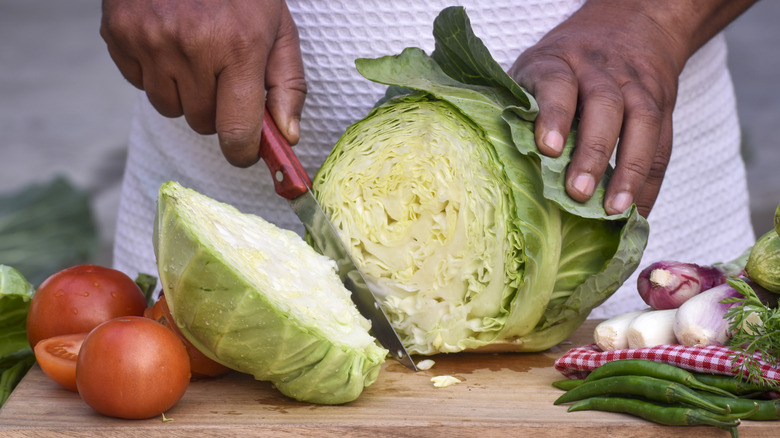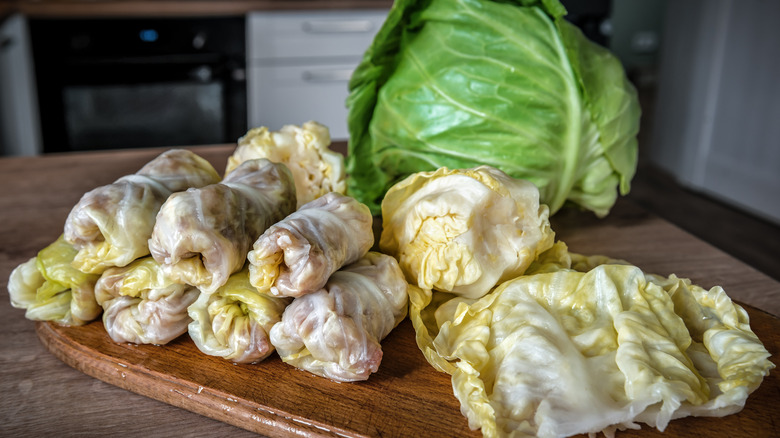How Cabbage Became A Traditional New Year's Day Food
Holidays around the world are often celebrated with food, and New Year's is no exception. The holiday has several food traditions associated with it, from Spain's 12 grapes at midnight eaten quickly right before the last clock strike on New Year's Eve, to the American South's black-eyed pea dish, Hoppin' John, the first meal served on New Year's Day. Another specific ingredient is eaten in a variety of ways on January 1st throughout parts of the United States as well as in its European countries of origin — cabbage.
By way of folklore and superstition, cabbage has come to represent good luck, along with many of the other foods that make up New Year's meals. The hopes and wishes for a new year are commonly for good health, prosperity, and wealth. Cabbage's green leaves can be seen as representing paper money, and in some preparations, it's even served with coins cooked right into it. One explanation for how cabbage came to symbolize luck and health for the new year is that due to it being a late-season crop, it's at its peak when few other fresh vegetables are available in the dead of winter. Ringing in the new year with a warm and nutritious helping of cabbage is meant to get you off to a good start.
Eat cabbage and pork for luck
Depending on which part of the country you are in, there are diverse ways that cabbage is cooked for New Year's Day. In the South, particularly in New Orleans and throughout Louisiana, Hoppin' John is often cooked with ham and served with greens — usually collard greens — and cornbread. However, it's also common for cabbage to be used instead of collards.
January 1st throughout Appalachia also means it's time for cabbage. In places like Kentucky, Pennsylvania, and the Virginias, cabbage rolls are stuffed with meat, usually pork — which is also considered a lucky food for the holiday — and come with a special surprise. It's customary to hide a silver coin inside the rolls, as a blessing for whoever would chance upon biting into it. This belief can be attributed to the Scottish and Irish who settled in the area in the 1700s and brought their food traditions with them. Along with its abundance in wintertime, cabbage was also one of the least expensive foods available at the time, which made it culturally significant both for the immigrants and local populations living in poverty.
How sauerkraut became a January 1st staple
The Midwest also has its own New Year's Day cabbage ritual — only there, it's in the form of sauerkraut. In Ohio, where there are many people of German and Eastern European descent, the traditional fermented cabbage is served with pork — either as a side or cooked together as a stew. This is also practiced in parts of Pennsylvania, thanks to the Pennsylvania Dutch. Individual strands of shredded sauerkraut were said to stand for many individual riches or as a wish for long life. Sauerkraut is traditionally prepared in time to be ready for winter when fresh foods are harder to come by and the preserved food could provide much-needed nutrients. In parts of Ohio with more Polish and Hungarian influences, sauerkraut is pan-fried in butter with smoked kielbasa sausage and onions.
There's one more reason cabbage — sauerkraut in particular — might be popular for New Year's Day, and that's because of its reputation for curing hangovers. While some might enjoy spending New Year's Eve drinking to celebrate the festive countdown, it's the next day's nausea and headaches that are a lot less fun. One supposed quick remedy is said to be found in a jar of sauerkraut, as well as other fermented foods. While there is no direct evidence that sauerkraut can directly fix a hangover, according to Women's Health, it can give you a boost of vitamins, probiotics, and antioxidants, which can help to alleviate dehydration, one cause of hangovers.



